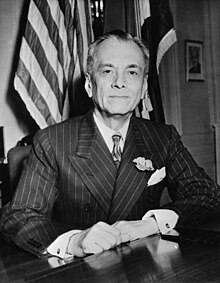Manuel L. Quezon | |||||||||||||||||||||||||||||||||||||||||||||||||||||||||
|---|---|---|---|---|---|---|---|---|---|---|---|---|---|---|---|---|---|---|---|---|---|---|---|---|---|---|---|---|---|---|---|---|---|---|---|---|---|---|---|---|---|---|---|---|---|---|---|---|---|---|---|---|---|---|---|---|---|
 Quezon in 1942 | |||||||||||||||||||||||||||||||||||||||||||||||||||||||||
| 2nd President of the Philippines | |||||||||||||||||||||||||||||||||||||||||||||||||||||||||
| In office 15 November 1935 – 1 August 1944 Serving with Jose P. Laurel (1943–1944)[a] | |||||||||||||||||||||||||||||||||||||||||||||||||||||||||
| Vice President | Sergio Osmeña | ||||||||||||||||||||||||||||||||||||||||||||||||||||||||
| Preceded by | Emilio Aguinaldo Frank Murphy (as Governor-General) | ||||||||||||||||||||||||||||||||||||||||||||||||||||||||
| Succeeded by | |||||||||||||||||||||||||||||||||||||||||||||||||||||||||
| Secretary of National Defense | |||||||||||||||||||||||||||||||||||||||||||||||||||||||||
| In office 16 July 1941 – 11 December 1941 | |||||||||||||||||||||||||||||||||||||||||||||||||||||||||
| President | Himself | ||||||||||||||||||||||||||||||||||||||||||||||||||||||||
| Preceded by | Teófilo Sison | ||||||||||||||||||||||||||||||||||||||||||||||||||||||||
| Succeeded by | Jorge B. Vargas | ||||||||||||||||||||||||||||||||||||||||||||||||||||||||
| Mayor of Quezon City | |||||||||||||||||||||||||||||||||||||||||||||||||||||||||
Acting | |||||||||||||||||||||||||||||||||||||||||||||||||||||||||
| In office 12 October 1939 – 4 November 1939 | |||||||||||||||||||||||||||||||||||||||||||||||||||||||||
| Vice Mayor | Vicente Fragante | ||||||||||||||||||||||||||||||||||||||||||||||||||||||||
| Preceded by | Position established | ||||||||||||||||||||||||||||||||||||||||||||||||||||||||
| Succeeded by | Tomas Morato | ||||||||||||||||||||||||||||||||||||||||||||||||||||||||
| Secretary of Public Instruction | |||||||||||||||||||||||||||||||||||||||||||||||||||||||||
| In office 1 December 1938 – 19 April 1939 | |||||||||||||||||||||||||||||||||||||||||||||||||||||||||
| President | Himself | ||||||||||||||||||||||||||||||||||||||||||||||||||||||||
| Preceded by | Sergio Osmeña | ||||||||||||||||||||||||||||||||||||||||||||||||||||||||
| Succeeded by | Jorge Bocobo | ||||||||||||||||||||||||||||||||||||||||||||||||||||||||
| |||||||||||||||||||||||||||||||||||||||||||||||||||||||||
| Personal details | |||||||||||||||||||||||||||||||||||||||||||||||||||||||||
| Born | Manuel Luis Quezon y Molina 19 August 1878 Baler, El Príncipe, Nueva Écija, Captaincy General of the Philippines, Spanish East Indies (now Baler, Aurora, Philippines) | ||||||||||||||||||||||||||||||||||||||||||||||||||||||||
| Died | 1 August 1944 (aged 65) Saranac Lake, New York, U.S. | ||||||||||||||||||||||||||||||||||||||||||||||||||||||||
| Cause of death | Tuberculosis | ||||||||||||||||||||||||||||||||||||||||||||||||||||||||
| Resting place |
| ||||||||||||||||||||||||||||||||||||||||||||||||||||||||
| Political party | Nacionalista (1907–1944) | ||||||||||||||||||||||||||||||||||||||||||||||||||||||||
| Spouse | |||||||||||||||||||||||||||||||||||||||||||||||||||||||||
| Children | 4 | ||||||||||||||||||||||||||||||||||||||||||||||||||||||||
| Relatives | Manuel L. Quezon III (grandson) | ||||||||||||||||||||||||||||||||||||||||||||||||||||||||
| Education | Colegio de San Juan de Letran | ||||||||||||||||||||||||||||||||||||||||||||||||||||||||
| Alma mater | University of Santo Tomas | ||||||||||||||||||||||||||||||||||||||||||||||||||||||||
| Signature | |||||||||||||||||||||||||||||||||||||||||||||||||||||||||
| Military service | |||||||||||||||||||||||||||||||||||||||||||||||||||||||||
| Allegiance | |||||||||||||||||||||||||||||||||||||||||||||||||||||||||
| Branch/service | |||||||||||||||||||||||||||||||||||||||||||||||||||||||||
| Years of service |
| ||||||||||||||||||||||||||||||||||||||||||||||||||||||||
| Rank | |||||||||||||||||||||||||||||||||||||||||||||||||||||||||
| Battles/wars | |||||||||||||||||||||||||||||||||||||||||||||||||||||||||
Manuel Luis Quezon y Molina[b] GCGH KGCR (UK: /ˈkeɪzɒn/, US: /ˈkeɪsɒn, -sɔːn, -soʊn/, Tagalog: [maˈnwel luˈis ˈkɛson], Spanish: [maˈnwel ˈlwis ˈkeson]; 19 August 1878 – 1 August 1944), also known by his initials MLQ, was a Filipino lawyer, statesman, soldier, and politician who was president of the Commonwealth of the Philippines from 1935 until his death in 1944. He was the first Filipino to head a government of the entire Philippines and is considered the second president of the Philippines after Emilio Aguinaldo (1899–1901), whom Quezon defeated in the 1935 presidential election. He is often regarded as the greatest President of The Philippines, and the quintessential Filipino statesman. Known as "The Father of The National Language", and "The Father of the modern Republic of The Philippines". He was also known as "One of the Finest Statesmen in the world" during his time.
During his presidency, Quezon tackled the problem of landless peasants. Other major decisions included the reorganization of the islands' military defense, approval of a recommendation for government reorganization, the promotion of settlement and development in Mindanao, dealing with the foreign stranglehold on Philippine trade and commerce, proposals for land reform, and opposing graft and corruption within the government. He established a government in exile in the U.S. with the outbreak of World War II and the threat of Japanese invasion. Scholars have described Quezon's leadership as a "de facto dictatorship"[1] and described him as "the first Filipino politician to integrate all levels of politics into a synergy of power" after removing his term limits as president and turning the Senate into an extension of the executive through constitutional amendments.[2]
In 2015, the Board of the International Raoul Wallenberg Foundation bestowed a posthumous Wallenberg Medal on Quezon and the people of the Philippines for reaching out to victims of the Holocaust from 1937 to 1941. President Benigno Aquino III and then-94-year-old Maria Zenaida Quezon-Avanceña, the daughter of the former president, were informed of this recognition.[3]
Cite error: There are <ref group=lower-alpha> tags or {{efn}} templates on this page, but the references will not show without a {{reflist|group=lower-alpha}} template or {{notelist}} template (see the help page).
- ^ Pante, Michael D. (26 January 2017). "Quezon's City: Corruption and contradiction in Manila's prewar suburbia, 1935–1941". Journal of Southeast Asian Studies. 48 (1): 91–112. doi:10.1017/S0022463416000497. S2CID 151565057.
- ^ McCoy, Alfred (1988). Quezon's Commonwealth: The Emergence of Philippine Authoritarianism.
- ^ "Quezon feted for rescuing Jews". The Manila Times. 19 August 2015.